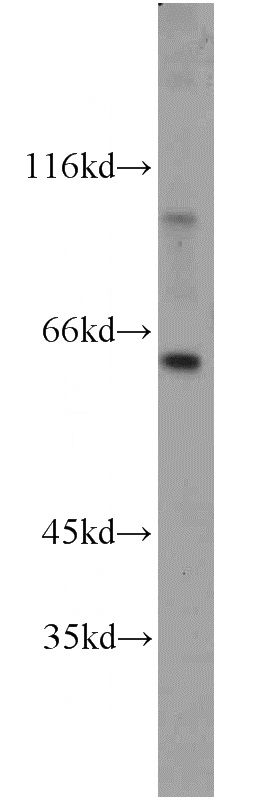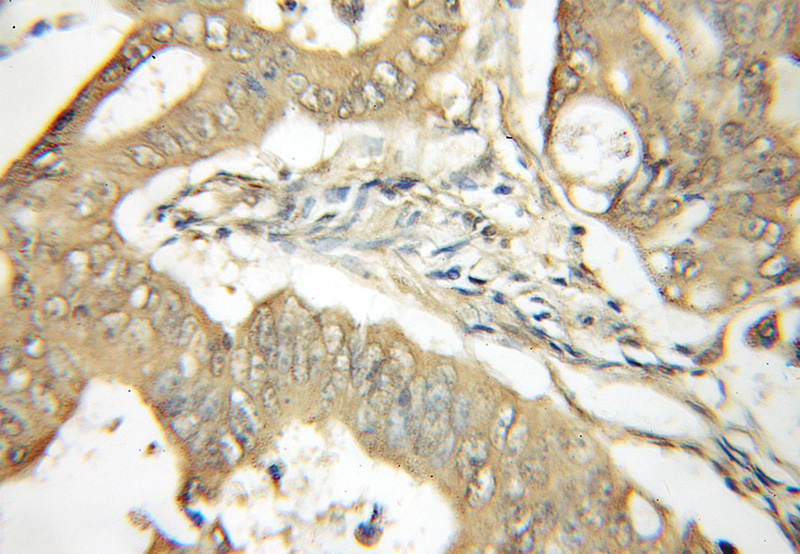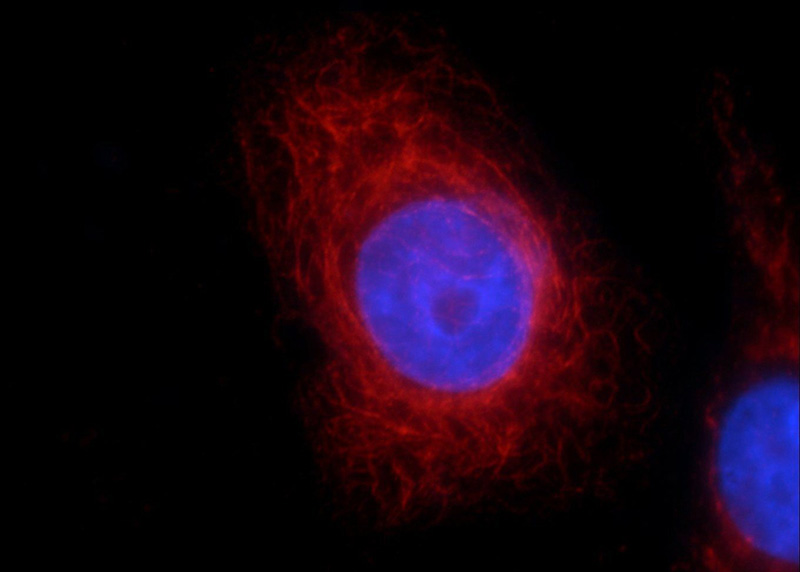-
Product Name
YME1L1 antibody
- Documents
-
Description
YME1L1 Rabbit Polyclonal antibody. Positive WB detected in mouse heart tissue. Positive IHC detected in human colon cancer tissue. Positive IF detected in HepG2 cells. Observed molecular weight by Western-blot: 86kd
-
Tested applications
ELISA, WB, IHC, IF
-
Species reactivity
Human,Mouse,Rat; other species not tested.
-
Alternative names
FTSH antibody; FTSH1 antibody; Meg 4 antibody; MEG4 antibody; PAMP antibody; YME1 like 1 (S. cerevisiae) antibody; YME1 like protein 1 antibody; YME1L antibody; YME1L1 antibody
-
Isotype
Rabbit IgG
-
Preparation
This antibody was obtained by immunization of YME1L1 recombinant protein (Accession Number: NM_014263). Purification method: Antigen affinity purified.
-
Clonality
Polyclonal
-
Formulation
PBS with 0.1% sodium azide and 50% glycerol pH 7.3.
-
Storage instructions
Store at -20℃. DO NOT ALIQUOT
-
Applications
Recommended Dilution:
WB: 1:200-1:2000
IHC: 1:20-1:200
IF: 1:10-1:100
-
Validations

mouse heart tissue were subjected to SDS PAGE followed by western blot with Catalog No:116887(YME1L1 antibody) at dilution of 1:300

Immunohistochemical of paraffin-embedded human colon cancer using Catalog No:116887(YME1L1 antibody) at dilution of 1:50 (under 10x lens)

Immunofluorescent analysis of HepG2 cells using Catalog No:116887(YME1L1 Antibody) at dilution of 1:25 and Rhodamine-Goat anti-Rabbit IgG
-
Background
YME1L1(ATP-dependent zinc metalloprotease) is also named as FTSH1, YME1L,Meg-4,PAMP. YME1L1 plays a phylogenetically conserved role in mitochondrial protein metabolism.It also ensures cell proliferation, maintains normal cristae morphology and complex I respiration activity, promotes antiapoptotic activity and protects mitochondria from the accumulation of oxidatively damaged membrane proteins. It has 3 isoforms produced by alternative splicing with the molecular weight of 86 kDa, 80 kDa and 76 kDa. This protein can migrate with a molecular weight of about 55-60 kDa, which is the size of the mature YME1L1 protein(PMID:22252130; 22354088).
-
References
- Mishra P, Carelli V, Manfredi G, Chan DC. Proteolytic cleavage of Opa1 stimulates mitochondrial inner membrane fusion and couples fusion to oxidative phosphorylation. Cell metabolism. 19(4):630-41. 2014.
- Ruan Y, Li H, Zhang K, Jian F, Tang J, Song Z. Loss of Yme1L perturbates mitochondrial dynamics. Cell death & disease. 4:e896. 2013.
- Richter-Dennerlein R, Korwitz A, Haag M. DNAJC19, a mitochondrial cochaperone associated with cardiomyopathy, forms a complex with prohibitins to regulate cardiolipin remodeling. Cell metabolism. 20(1):158-71. 2014.
- Baburamani AA, Hurling C, Stolp H. Mitochondrial Optic Atrophy (OPA) 1 Processing Is Altered in Response to Neonatal Hypoxic-Ischemic Brain Injury. International journal of molecular sciences. 16(9):22509-26. 2015.
- Li H, Ruan Y, Zhang K. Mic60/Mitofilin determines MICOS assembly essential for mitochondrial dynamics and mtDNA nucleoid organization. Cell death and differentiation. 23(3):380-92. 2016.
- Richter U, Lahtinen T, Marttinen P, Suomi F, Battersby BJ. Quality control of mitochondrial protein synthesis is required for membrane integrity and cell fitness. The Journal of cell biology. 211(2):373-89. 2015.
- Ehses S, Raschke I, Mancuso G. Regulation of OPA1 processing and mitochondrial fusion by m-AAA protease isoenzymes and OMA1. The Journal of cell biology. 187(7):1023-36. 2009.
- Hornig-Do HT, Tatsuta T, Buckermann A. Nonsense mutations in the COX1 subunit impair the stability of respiratory chain complexes rather than their assembly. The EMBO journal. 31(5):1293-307. 2012.
Related Products / Services
Please note: All products are "FOR RESEARCH USE ONLY AND ARE NOT INTENDED FOR DIAGNOSTIC OR THERAPEUTIC USE"
